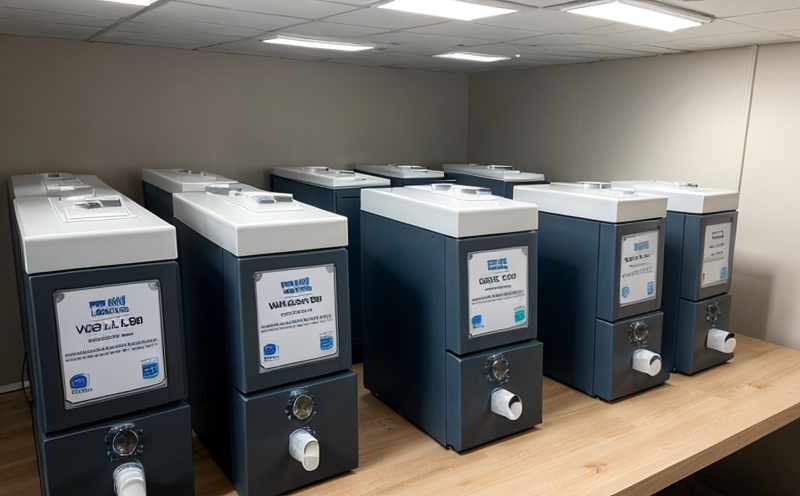ASTM D7143 Measurement of volatile emissions from adhesives
The ASTM D7143 standard provides a method to measure volatile organic compound (VOC) emissions from adhesives. This is crucial for ensuring that products meet environmental and health safety standards, particularly in sectors where air quality is paramount such as construction and furniture manufacturing.
This test measures the amount of VOCs released by adhesives under controlled conditions, which helps manufacturers ensure compliance with international standards like ISO 16000-6. The procedure involves placing a sample on a substrate and exposing it to a flow of air for a specified time period. The collected gases are then analyzed using gas chromatography.
The ASTM D7143 test is particularly important because VOCs can have harmful effects on human health, including respiratory issues and skin irritation. By measuring these emissions, manufacturers can take steps to reduce their environmental impact and improve product safety. This testing ensures that products meet the stringent requirements of regulations such as California Air Resources Board's (CARB) Low-VOC standards.
The test is widely used in various industries including furniture manufacturing, automotive interiors, and building materials. It helps companies comply with local and international environmental protection laws while also ensuring product quality and safety. The results from ASTM D7143 are critical for maintaining a competitive edge in the market by demonstrating commitment to sustainable practices.
For R&D engineers, this test is essential for developing new adhesive formulations that meet both performance and regulatory requirements. By understanding how different components affect VOC emissions, they can optimize their products for efficiency and safety. Quality managers rely on these tests to ensure consistency across production batches, while compliance officers use the results to verify adherence to legal standards.
The ASTM D7143 test is typically conducted in a climate-controlled chamber with controlled humidity levels. The sample size varies depending on the type of adhesive being tested, but it generally ranges from 250 grams to several kilograms. After exposure to air flow for 6 hours at 23°C and 50% relative humidity, the emitted VOCs are collected and analyzed.
The testing process is critical in ensuring that adhesives meet not only environmental standards but also performance expectations. For instance, in furniture manufacturing, VOC emissions from adhesives can affect indoor air quality (IAQ). By adhering to ASTM D7143 guidelines, manufacturers can ensure they are producing safe products that contribute positively to IAQ.
The ASTM D7143 method is versatile and applicable across various adhesive types. It helps in identifying any potential issues early in the development process, allowing for necessary adjustments before mass production begins. This proactive approach ensures that the final product not only meets regulatory requirements but also exceeds them by providing safer environments for consumers.
The importance of ASTM D7143 cannot be overstated, especially given increasing global awareness about indoor air quality and health concerns linked to VOC exposure. By implementing this standard, companies demonstrate their commitment to sustainability and consumer safety, thereby building trust with customers and stakeholders.
Scope and Methodology
| Parameter | Description |
|---|---|
| Sample Preparation | The sample should be cut to a standard size and weight, typically between 250 grams and several kilograms. It is placed on a substrate and exposed to air flow. |
| Environmental Conditions | The test must be conducted in a climate-controlled chamber with a temperature of 23°C ± 1°C and relative humidity of 50% ± 5%. Exposure time is set for 6 hours. |
| Gas Collection | Gases emitted from the sample are collected over a period of 6 hours. They are then analyzed using gas chromatography to identify and quantify VOCs. |
- This method is used in various industries, including furniture manufacturing, automotive interiors, and building materials.
- The results ensure compliance with international standards like ISO 16000-6 and local regulations such as CARB Low-VOC standards.
Industry Applications
The ASTM D7143 test is widely used in several industries where VOC emissions from adhesives can impact product quality and consumer safety. Furniture manufacturers use this method to ensure that their products meet stringent environmental regulations while providing a safe indoor environment for consumers.
- In the automotive sector, adhesives play a crucial role in ensuring structural integrity of vehicles. By measuring VOC emissions using ASTM D7143, automakers can verify compliance with international standards and improve IAQ within vehicle cabins.
- Building materials manufacturers also benefit from this test as it helps them comply with local and international regulations related to indoor air quality.
Customer Impact and Satisfaction
The ASTM D7143 method significantly impacts customer satisfaction by ensuring that products meet environmental and health safety standards. Consumers are increasingly concerned about the quality of indoor air in homes and offices, making compliance with this standard essential for maintaining a competitive edge.
- By using ASTM D7143, companies can demonstrate their commitment to sustainability and consumer safety, thereby building trust with customers.
- The results from this test help manufacturers optimize their products for both performance and regulatory compliance, leading to higher customer satisfaction levels.





